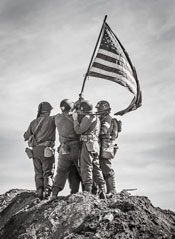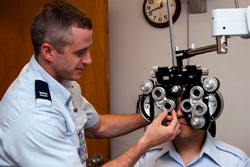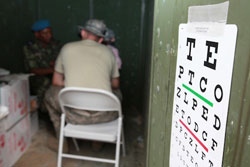 NEW YORK—Today is Veterans Day, the federal holiday when Americans formally recognize the contributions of those who have served in our nation’s armed forces. But what about the contributions of the vision care professionals who care for our veterans? Don’t they deserve some recognition, too?
NEW YORK—Today is Veterans Day, the federal holiday when Americans formally recognize the contributions of those who have served in our nation’s armed forces. But what about the contributions of the vision care professionals who care for our veterans? Don’t they deserve some recognition, too?
To learn about the vital role that optometrists, ophthalmologists, opticians and other professionals play in providing vision care for veterans, VMail Weekend asked one of Vision Monday’s Most Influential Women in Optical, H. Lindsay Wright, OD. As executive director of the Armed Forces Optometric Society, (AFOS) Dr. Wright is responsible for overseeing the administration, programs and strategic plan of The AFOS, the affiliate of the American Optometric Association (AOA) that represents all federal service optometrists including those in active duty and reserve military (Air Force, Army, and Navy), the Department of Veteran's Affairs (VA), Indian Health Service and Public Health Service. Her other key duties include advocacy, membership, planning of continuing education events and sponsorship.
 H. Lindsay Wright, OD
H. Lindsay Wright, OD
Executive Director
Armed Forces
Optometric Society“VA doctors of optometry work in concert with the VA's other health care professionals in the management of numerous medical conditions that can affect the eye such as diabetes and hypertension. This inter-professional communication to effectively coordinate care not only ensures that our veterans receive the best possible care, but it also provides an economical and efficient path for veterans to receive their health care.”
VMail Weekend asked the Department of Veterans Affairs for some facts and figures that illustrate the extent of the vision care services it provides to veterans. Here’s what a VA spokesperson told us:
- The VA spent approximately $667 million on vision care in 2016.
- In 2017, the VA provided eyecare services (optometry and ophthalmology) to about 1.79 million veterans.
- This year, the VA distributed approximately 1.65M pairs of eyeglasses, and more than 19,000 contact lenses.
 The VA expects to provide about 225,000 new veterans with optometry care and comprehensive eye examinations with refraction this year. This estimate does not include the more than 338,000 established patients.
The VA expects to provide about 225,000 new veterans with optometry care and comprehensive eye examinations with refraction this year. This estimate does not include the more than 338,000 established patients.- Currently, Veterans Health Administration (VHA) employs 949 VA staff optometrists and 220 optometry residents. The VA trains approximately 1,250 optometry students annually. There are 46 health technicians (opticians). VHA employs 777 staff ophthalmologists.
- As of Sept. 30, the VA operates 386 sites that provide optometry and/or ophthalmology eyecare services. About 45 percent of these sites have both optometry and ophthalmology; 50 percent have optometry only and 5 percent have ophthalmology only.
- To date, the VA provides care to about 39,000 low-vision veterans.
- In 2016, the VA had more than 45,000 blinded veterans on case rosters. The VA provided care to about 24,000 of these unique patients that year.
 In FY 2016, there were over 9.05 million enrolled veterans with about 6.26 million active users of VA Health Care.
In FY 2016, there were over 9.05 million enrolled veterans with about 6.26 million active users of VA Health Care.- VA Optometry Service provided care for about 1.41 million unique veterans in FY 2016.
- Over 71 percent of the total unique veterans eyecare services annually were cared for by VA optometrists.
- Optometrists provide the following essential services to veterans: diabetic retinal exams, low vision and blind rehabilitation, and traumatic brain injury.
- The VA is the training ground for many of its optometrists. About 1,500 to 1,600 optometry student externship rotations are available every year, and 220 optometry residency positions.
“With the implementation this year of direct scheduling, veterans’ access to optometry services has improved,” the VA spokesperson said. “The VA’s National Teleretinal Imaging Screening Program screened approximately 191,000 veterans in 2017 for diabetic retinopathy. The VA and the Department of Defense collaborated on “Vision Center of Excellence (VCE) Clinical Recommendation for the Eye Care Provider” recommendations for improved care for service members and Veterans with eye injuries and traumatic brain injury (TBI) impacting vision.”
With such extensive vision care resources available to veterans, it seems clear that their eyes are in good hands.